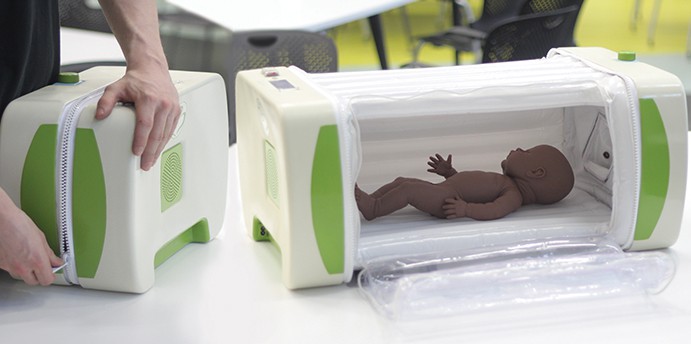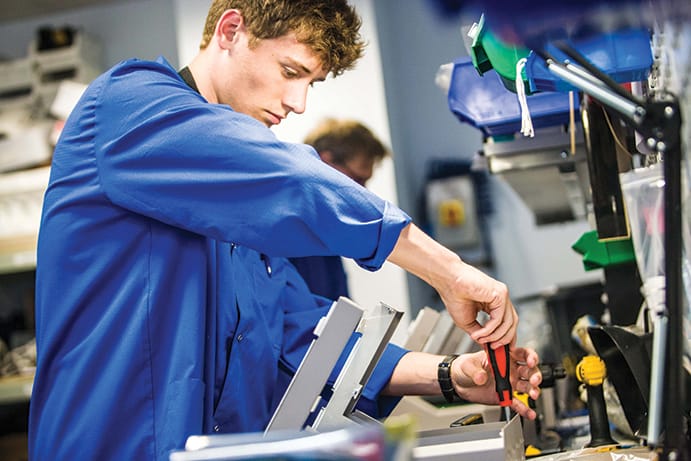It’s often said that, despite the large budgets and dedicated facilities available to corporations, the most innovative companies are the smaller ones. Morgan Innovation and Technology (IAT) is a case in point. Based in an identikit building on an identikit industrial estate near Petersfield, the company operates mainly in the highly regulated and competitive medical technology sector, and specialises in new technologies.

The Engineer met Nigel Clarke, Morgan IAT chief executive, who has taken over the running of the company from his father, Howard, who founded Morgan with his wife Sue around 30 years ago. The company offices above the shop floor have the cosy atmosphere of a small family operation, even including a large friendly dog whose toys litter Sue Clark’s office, where she still oversees company finances.
Howard Clarke worked for British Steel as an electrical engineer for many years, and founded Morgan to commercialise a device to alleviate chronic pain. Based around radio-frequency nerve ablation, which involves directing microwaves at the nerve transmitting pain to the brain to heat water in the nerve sheath to prevent the pain signal from travelling, Clarke developed a range of devices under the name Neurotherm. “My father invented it with my brother’s godfather, who was a GP living down the road; this was an entirely new process and it is still the leading device for this form of pain relief,” Nigel Clarke explained. “We sold the rights about 25 years ago to a very large medical equipment company based in Minnesota; we manufacture the device for it and it sells it around the world. We make about 600 per year. The device itself is worth a few thousand pounds, but it’s one of these things where the money is made on the consumables: every use of the machine requires a fresh needle. Each treatment lasts between one and five years, and it’s extremely effective; there are some cases where patients have come in using a wheelchair and walked out.”
Personal connections such as this seem to have been very much a running theme in Morgan’s development. Both Howard and Nigel often start stories with phrases such as “I was sitting next to a chap at a dinner party” or “we met some people at a trade exhibition”. It explains what might seem a lack of coherence in the company’s products: unlike companies that develop around a specific technology or a range of related conditions, Morgan’s portfolio is extremely diverse with the only common thread seeming to be addressing conditions that lack effective treatments.
Take snoring, for example. It’s annoying and can be harmful when it interferes with sleep patterns, but except in cases where it is a symptom of severe sleep apnoea, where the sufferer actually stops breathing while sleeping, it is notoriously difficult to treat. Morgan is currently developing a device developed by a consultant at King’s College London for mild apnoea that attaches to the underside of the jaw and uses a mild electric current to stimulate the muscles of the tongue just enough to tense it and prevent the vibrations that cause snoring, but not enough to wake the user. “You attach the device to an adhesive, conductive pad that sticks just behind your chin and adjust the level of stimulation yourself; it works little bit like a TENS machine for controlling pain,” Clarke said. “We carried out a clinical trial with the team at King’s that was published earlier this year [2016], and it could be on the market in the next couple of years.”

One of Morgan’s strengths as a small company is its ability to do development work in house and work closely with its medical collaborators. Another of its products, a device to prevent and treat diabetic foot ulcers, is a case in point. “The original company developing it had been working on the concept for a couple of years and had been to various consultants to turn it into a product but without any luck,” Clarke explained. “We can consolidate all the development areas and we negotiated a deal whereby we gave it 12 months of credit because it was a start-up, and we became the manufacturer at the end of it.”
The device fits inside a large shoe, and consists of a series of bladders set into the insole that inflate and deflate to relieve pressure on the sole of the foot, controlled by an electrical unit containing pumps that sits at around calf level. The company is now launching an aggressive sales strategy in the US, with a softer launch in Europe and Australia.
Developing the diabetic boot led to another chance connection. Howard Clarke, who has stepped back from running the company but is still heavily involved in development and engineering, was in fact looking for somebody to supply a waterproof sleeve to protect a cast on his wife’s leg after she was injured in a car accident, and found a prospective supplier via a leaflet in a doctor’s waiting room, Nigel related. “It turned out to be only 20 minutes away, so when I ordered one [the company] invited me over to have a look around. Its speciality is seam welding, so when we needed welded bladders to go into the sole of the boot they were an obvious choice.
“And then about three or four months ago, [the supplier] came up with a new idea themselves, for hot and cold therapy for muscle injuries.” As a former rugby player, this is something that Nigel is very familiar with. “We happened to have done some work on this ourselves, so I went and retrieved our previous material. The idea is the product uses a sleeve attached to a control box that contains hot water in one chamber and ice water in another, and you put it onto the affected part and it applies pulsing pressure and alternate heat and cold. Basically, it’s a more effective replacement for Tubigrip and a bag of frozen peas, which is what we used to do for injuries. This isn’t something that is going to make a huge difference to society, but it can fund things that will make a huge difference and that is what we are really interested in.”
Those looking for connections would be tempted to think that electricity might be the link between all of Morgan’s products. But even this would be a mistake. Morgan’s latest launch is a test for pre-eclampsia, a condition connected with high blood pressure that occurs in pregnancy and can be life threatening. “Our financial director was at a dinner party with a doctor’s brother; they got chatting, and the doctor was a rheumatologist who had done a very small clinical trial on using uric acid as a biomarker for pre-eclampsia in pregnancy. He had managed to prove his theory but needed help in progressing the idea,” Clarke said.
This concept has now been developed into a test that Morgan is developing under the name Salurate, a bioassay that works by inducing a colour change in a test swab that reacts to a saliva sample. The patient then takes a picture of the swab on a smart phone and sends it to a clinician; a positive test indicates a need for close monitoring.
Clarke believes that Salurate can be a lifesaver. “We are not purely driven by money here,” he said. “We are a family company and we fortunately make good money. Our overriding drive is to produce products that will generally make a difference.”
Another potential lifesaver is a battery-operated inflatable incubator concept that won its inventor, James Roberts, the James Dyson award in 2014 when he was a student at Loughborough University. Morgan is working with on developing this with Roberts, who plans to bring it to the market through his own company, mOm Incubators, which is also backed by Holly Branson.




Red Bull makes hydrogen fuel cell play with AVL
Surely EVs are the best solution for motor sports and for weight / performance dispense with the battery altogether by introducing paired conductors...